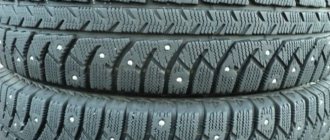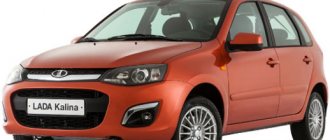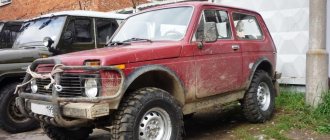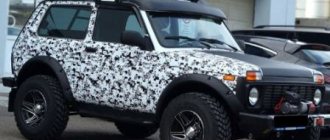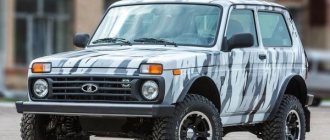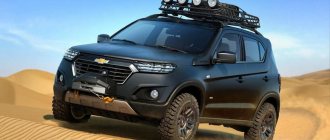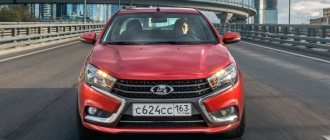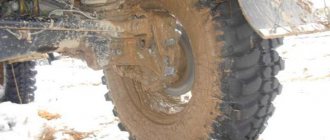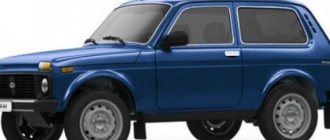Many are considering buying a Chevrolet Niva for the purpose of using it in winter. That's right, because snow drifts, snowdrifts, and icy ruts are what you need for an off-road vehicle, especially with honest permanent all-wheel drive. Next, I will allow myself to speculate on the topic of winter driving in a Chevrolet Niva. Everything stated below is based on my personal experience of operating Shnivy for 8 years and is my opinion, which may differ from the opinions of other owners of this car.
The correct distance is a guarantee of safety
Everyone knows that the braking distance on a slippery highway increases several times, but not everyone wants to remember this. In winter, when driving on the road, you must keep your distance.
The distance to the car moving ahead should be 2 times greater than in the summer. Only at such a distance can you safely brake without causing harm to the stopped or moving car in front.
You also need to be extremely careful in your attitude towards pedestrians crossing the road or walking along the side of the road.
Preparing the Chevrolet Niva for winter
Winter tires for Shniva
In fact, any off-road vehicle is initially ready for use in difficult road conditions, incl. and in winter. The fundamental point is good winter tires. When choosing winter tires for an SUV, I recommend giving preference to tires with thinner tread and pronounced lugs. This will ensure better wheel traction in loose snow. On my Shniva I used two sets of winter tires: Bridgestone WT14 and Cooper Weather Master S/t 2. The first in size 205/75 R15, the second 215/75 R15. I really liked Bridgestone and, in my opinion, is the standard of winter tires for SUVs. Unfortunately, this model is no longer produced, although if you manage to find some leftovers somewhere, I definitely recommend purchasing it. I've been driving a Cooper Weather Master for the past few years. In general, the tires are not bad and I can also recommend them for purchase. Some time ago I wrote an article about these tires, so I recommend you read it. As for the tire pressure, during normal city use I always keep it at 2 atmospheres, just like in the summer. If there is a need to drive on loose snow for a long time or there is a risk of getting stuck, then you can lower the wheels to 1.5 atmospheres, but the main thing is not to overdo it.
Reliable battery and working generator
Few people want to find themselves somewhere far from home, in the forest, in the cold and with a car that cannot be started. In some situations, the consequences can become quite serious. And if in the warm season the poor condition of the battery or generator was completely unnoticeable, then in the winter everything can surface to the surface already at the first significant cold snap. If you have a voltmeter (the simplest one for 200 rubles will do), then I recommend measuring the voltage on the battery with the engine off and while it is running. The normal voltage of a working battery is 12.6-12.7 V. While the engine is running, the generator should consistently output 13.8-14 V with consumers turned on (stove, music, low beam). If your voltage drops to 13.5 V and below, then most likely there is a constant undercharging, which is very critical, especially with short runs. I recommend measuring voltage at the battery terminals and not relying on the voltmeter readings on the dashboard. As a rule, the latter’s indicators always differ from the real ones to a lesser extent. In addition, it will be useful to identify current leaks while the car is parked. In my case, I struggled with this for a long time, but everything turned out to be simpler - the reason was in the radio panel, which I had not removed before.
Shovel, cable, winch
During normal city use, you are unlikely to need to dig out a parking space for yourself even in the most severe snowfalls. A shovel can come in handy during out-of-town trips or to help dig out another car.
Of course, it is always recommended to carry a cable, and it is better if it is not simple, but jerky (dynamic). With the latter, it will be much easier for you to pull out a car stuck tightly in the snow. And in this case, many people love the Chevrolet Niva and as soon as they see it, they immediately call for help for the stranded one. Whether or not to help everyone you meet is a personal matter, but it’s still worth considering such a situation. Moreover, you yourself may need help.
A winch is a useful thing and indispensable in conditions of frequent winter trips to the forest. Of course, not everyone is ready to install a very expensive electric winch on their car in order to use it once or twice a year. But there is an option to purchase an inexpensive manual winch and carry it in the trunk. It is not as convenient as a stationary one and somewhat narrows your options, but, nevertheless, it is also very effective and can serve you well.
Moderate speed
You should not drive too hard on a snowy road. It is better to move slowly and smoothly.
On a slippery road, you should not drive at a speed of more than 40-50 km/h, because otherwise there is a high risk of skidding or the car becomes uncontrollable when braking.
Tram tracks also need to be crossed slowly to prevent the car from skidding.
Drivers of cars with a gearbox in icy conditions keep their foot over the brake, and not over the gas pedal, as in the summer. In an unusual situation, the foot instinctively falls on the pedal.
Basic moments
There are a number of other reasons for the increase in gasoline consumption by these cars:
- high-quality gasoline - you need to refuel at reliable gas stations. By filling up with suspicious gasoline at an unknown gas station, you are putting fuel filters at risk;
- the fuel system must be kept clean, the jets must be cleaned constantly;
- severe wear of piston rings, pistons and cylinder block can increase fuel consumption;
- reducing compression in the engine gives the same result - high fuel consumption;
- Incorrect injector setting.
How to brake correctly?
Worse than icy conditions is slippery asphalt covered with a thin layer of snow.
Studded tires are designed to improve the grip of wheels on ice, but when the ice crust is covered with snow, the studs are ineffective because the snow sticks to them and the rubber slides heavily on the asphalt.
It is necessary to brake on such a track impulsively, without allowing the wheels to completely lock.
Pressing the brake for 4-5 seconds prevents the ABS from working, which doubles the braking distance of the car on an icy crust.
You should not press the brake suddenly to avoid prolonged sliding on the road.
Riding on ruts
The biggest problem on a winter road is the ruts. When a car moves even at low speed along a track, it can skid.
Under these conditions, the driver must constantly keep his arms tense to allow the car to rock slightly (yield steering) but control the speed and position of the steering wheel.
If the rear end skids on a front-wheel drive car, you need to increase the speed, and on a rear-wheel drive car, reduce it a little, but do not brake.
Control over other road users
On the highway you shouldn’t think only about yourself - you need to control the traffic on the road in order to be fully prepared in an unusual situation. On a winter road, it is better not to turn on loud music in the car, but to carefully observe and listen to the sounds outside the window - maybe someone will drift in your direction.
Compliance with the rules of driving on slippery and snowy roads will not only preserve the integrity of your car, but also the health and life of all road users. Do not neglect safety rules in winter.
Source
How to cope if the car skidded?
It is very difficult to control a car that has started to spin and is already skidding. Such car dances on ice often end in serious accidents. If the car starts to spin, you need to put the wheels straight - this stops the spinning.
When skidding, keep the steering wheel straight or turn it in the direction of the skid and apply the brakes slightly. When braking, the weight of the car will shift to its front, and the traction of the wheels on the asphalt increases, which will help level the car.
Driving through intersections
Experienced drivers recommend adhering to traffic rules at an intersection, but advise not to forget about the unwritten rule of traffic rules - “give way to a fool.”
When approaching an intersection, you need to make sure that there is no car that intends to get in front of you. In this case, it is better to wait for him to complete the maneuver and only then continue moving.
Also, you should not try to drive through an intersection when the traffic light is yellow, because on the transverse side there will also be those who like to drive fast, which will inevitably lead to a collision.
Lada Vesta
Let's get down to specifics.
Regardless of the type of drive and engine power, reduce the gas pedal travel. Tea, not a button, allows you to dose accurately. Let me explain. When starting from a stop and when accelerating after changing gears, you do not need to press the pedal to the floor. And engine braking, described by the common phrase “cover the gas,” does not mean that you almost have to take your foot off the pedal. It is enough to slightly release it. This is because a sudden release of the gas or a sudden release of the gas can cause the drive wheels to slip. Especially in lower gears.
Imagine a playground. A snake of cones is arranged. A car maneuvers between them at low speed. The unfortunate driver was sweating from the effort of grabbing the rim. Hands are already intertwined. That's right - high-speed taxiing needs to be practiced. Everyone knows that he turned the wheels in the direction of the skid, which means he leveled the car. Only turning the steering wheel with interception is insurance in case of a very serious mistake, when the car has already fallen into a deep skid.
On a normal road, where speeds are higher, it is better not to skid at all. How? Turn the steering wheel at small angles without jerking, that is, do not provoke the steering wheels to slip into sliding and rocking of the body. If the stern drags, counter with a barely noticeable turn of the steering wheel in the direction of the skid, without reaching critical angles. The main thing is not to keep the wheels turned, and not to wait for the car to react. They swung the rim there and then back again. If you get stuck, you risk rocking the car, shifting from one skid to another. Unfortunately, there is practically no place to train recovery from a drift or skid at high speed - there are very few suitable, and even well-equipped sites.
Drivers of cars with a manual transmission need to train themselves not to drop the clutch when shifting and to press the gas in a timely manner. The task is to eliminate jerks. In summer they are not so bad, in winter they cause the wheels to slip. Automatic transmissions also require delicate gas operation. You can get used to it and get them to start and shift smoothly. Sometimes it makes sense to switch to manual control mode and lock the desired gear in order to get rid of shifting (read: removing traction from the drive wheels) at the wrong moment.
Braking: the same principle - on a slippery road, do not provoke wheel locking. In the final deceleration stage, reduce the pedal force. What in summer is an uncomfortable peck, in winter - a breakdown in sliding. It is not difficult to learn how to brake when the wheels are on the verge of locking; you can practice this technique on public roads.
Classic model
The classic model was based on the first JW speaker model. I won’t say that it was successful, but the quality of light was no worse than that of standard headlights; overall, everything was good: a clear cut-off line, a central accent in the top line. When the Chinese started copying it, everything was very bad, they confused the near and far lenses, and could not focus the LEDs they used. The first year of production of these headlights in China was a complete disappointment, after a year and a half, several companies still received good results, from that moment these headlights began to be massively imported into the Russian Federation by suppliers. Mostly these were good headlights, but unsuccessful models also slipped by. We sold these headlights from 2014 to 2022, the latest improvements to these headlights on Osram LEDs were extremely successful, but in 2022 we stopped supplying these headlights and finally switched to models with dual lenses.
Although it is worth noting that the Criline Sharp model is still supplied by us to order and is the standard for 7-inch LED headlights. But all the components are custom, and despite all the external similarities, Sharp’s internals are radically different.
Chevrolet Niva
Modern electronic systems are a good examiner. If in winter the stabilization system does not choke the engine when cornering, the anti-skid light does not blink when accelerating, and the ABS does not chirp when stopping, then in normal situations you are doing everything correctly. That is, you do not provoke the car.
The conclusion is simple: on
Follow a soft management style and you will gain confidence in winter. And the newly acquired “feeling for the car” will help you master emergency training techniques if you want to improve further.
